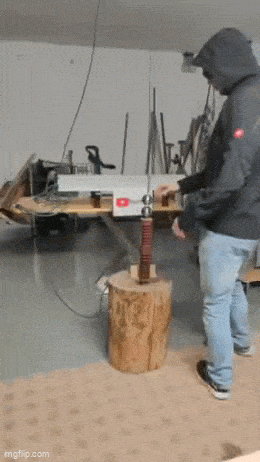Join the Hide community
Get access to live stream, lessons, the post exchange, and chat with other snipers.
Register
Download Gravity Ballistics
Get help to accurately calculate and scope your sniper rifle using real shooting data.

Install the app
How to install the app on iOS
Follow along with the video below to see how to install our site as a web app on your home screen.
Note: This feature may not be available in some browsers.
Maggie’s Motivational Pic Thread v2.0 - - New Rules - See Post #1
- Thread starter Snake-Eyes
- Start date
-
- Tags
- motivational pictures
Here’s some “1000hp” boats for y’all to enjoy.
2 props? Maybe it’s a w-drive….but those aren’t real.



 <-W-drive
<-W-drive

here’s a nonexistent W-drive.


hey, is that a w-drive?

probably not…
2 props? Maybe it’s a w-drive….but those aren’t real.
here’s a nonexistent W-drive.
hey, is that a w-drive?
probably not…
Last edited:
Just because it has a shipping label going to a Mercedes location doesn't mean it fits a Mercedes vehicle. The Mercedes dealership might have a body shop that is Tesla certified to install the battery, or the Mercedes service department might be Tesla certified. My son works for Tesla where they build the batteries and has never said anything about them making a Mercedes spec battery. They are so busy building batteries for their own production they don't have time to build them for anyone else.You are reading that correctly, Tesla and Mercedes on the same pack.
That’s what’s so laughable about people who argue my Chevy, Ford, Dodge, BWM is better. Got no idea how much these manufactures are in cohorts together behind the scenes.
That particular gem in the crate is for an older B class Mercedes that a was about $11k. Don’t remember all the particulars on capacity as I wasn’t the one working on it, but it’s a lunch box of a car with city driving range.
https://www.enginelabs.com/news/video-test-shows-top-fuel-nitro-engine-makes-over-11000-horsepower/They don't/can't dyno the TF engines. From what I gather the issue isn't so much the dyno itself, but that the engines won't/can't run for long enough to get a proper read.
Clay Millican has something about that on one of his Q&A videos.
Man, there I go being wrong again
top fuel, fuel systems are crazy.
Here’s some “1000hp” boats for y’all to enjoy.
2 props? Maybe it’s a w-drive….but those aren’t real.
View attachment 8296715View attachment 8296716View attachment 8296717
View attachment 8296718<-W-drive
View attachment 8296719
here’s a nonexistent W-drive.
View attachment 8296720View attachment 8296721
hey, is that a w-drive?
View attachment 8296722
probably not…
The 2024 Drag Boat Nationals are in Chandler AZ. We should go.
Would
Maybe we could touch @clcustom1911 hair
You did see where I said I am a MB tec at a MB dealer and that it is in our service department this very moment and that particular crate went into a Mercedes B class ev? There is no speculation of what kinda sorta might be.Just because it has a shipping label going to a Mercedes location doesn't mean it fits a Mercedes vehicle. The Mercedes dealership might have a body shop that is Tesla certified to install the battery, or the Mercedes service department might be Tesla certified. My son works for Tesla where they build the batteries and has never said anything about them making a Mercedes spec battery. They are so busy building batteries for their own production they don't have time to build them for anyone else.
Wanna see it? Come on down, I’ll give you a tour and let you look at it with your own eyeballs, provided you show up by Monday before it ships out. Mercedes-Benz of Wesley Chapel.
Back to what I said earlier about people arguing over what hood ornament is better… there is so much manufacture cross pollinating going on behind the scenes.
Yes Tesla build their own batteries. Yes Benz builds their own batteries. They also contract share. The $68k battery, not sure what plant that one is coming out of.
The EV battery in the crate that I posted is 100 percent joint manufactured by Tesla and Benz.
I captured a photo exactly like that last year.
Maybe @Dirty D would be there too and we could pick up on his left overs, or at least visit his dubba wide luv shak.Maybe we could touch @clcustom1911 hair
I doubt @clcustom1911 would let us touch his hair. He might let us touch his Krautcycle though.
Wow, is that two props on a W-drive?!?!
ill quit lol
But could we smell his hair?Maybe @Dirty D would be there too and we could pick up on his left overs, or at least visit his dubba wide luv shak.
I doubt @clcustom1911 would let us touch his hair. He might let us touch his Krautcycle though.
One of the things haven't seen anyone address during this riveting conversation about horsepower is, the parasitic draw just to spin a top fuel blower is almost 1000hp. It would take everything an SRT Demon 170 engine could do just to spin the blower for a top fuel car.That’s only 1000hp…
Its crazy TF teams with all their backing will blow an engine in half and weld it back together.

One of the things haven't seen anyone address during this riveting conversation about horsepower is, the parasitic draw just to spin a top fuel blower is almost 1000hp. It would take everything an SRT Demon 170 engine could do just to spin the blower for a top fuel car.
View attachment 8296752
I was going to, but didn’t lol
I’m old so they all look too youngIt's a bit suspect when certain members think every other model is underage.
Holy crap….
Look at this one:
$56k for a Hyundai battery!!! whoa
I'm curious about this from a lenders standpoint. Say your POS EV battery takes a shit. Costs 30-40k for a replacement......which you can't afford, yet the car payments keep rolling in. You say fuck it and let the bank repo the POS and your credit rating goes to shit. WTF are they gonna do with a basically worthless vehicle that no one wants to buy? I'm surprised banks want any part of these.
The banks not gonna care if anybody buys it or not.I'm curious about this from a lenders standpoint. Say your POS EV battery takes a shit. Costs 30-40k for a replacement......which you can't afford, yet the car payments keep rolling in. You say fuck it and let the bank repo the POS and your credit rating goes to shit. WTF are they gonna do with a basically worthless vehicle that no one wants to buy? I'm surprised banks want any part of these.
What they’re gonna do is sue the fuck out of the owner and get their money.
Last edited:
No- you drive it into a lake.I'm curious about this from a lenders standpoint. Say your POS EV battery takes a shit. Costs 30-40k for a replacement......which you can't afford, yet the car payments keep rolling in. You say fuck it and let the bank repo the POS and your credit rating goes to shit. WTF are they gonna do with a basically worthless vehicle that no one wants to buy? I'm surprised banks want any part of these.
pretty cool read!Yes, an entire class of racing is made up lol
its all fake, a conspiracy if you will!
View attachment 8296686
View attachment 8296688View attachment 8296689
it’s all fake…
let’s also forget the fact prop pitch can change the RPM.
I haven’t been to a drag boat race since I lived in SoCal. I think they use to run them at Lake Elsinore, but it’s been a while, I think back in the late 70’s early 80’s? Eddie Hill was my favorite, as he ran both TF boats and cars. God I’m old……
One of the things haven't seen anyone address during this riveting conversation about horsepower is, the parasitic draw just to spin a top fuel blower is almost 1000hp. It would take everything an SRT Demon 170 engine could do just to spin the blower for a top fuel car.
View attachment 8296752
Well akshoelly, it was mentioned as one of the items in the whole top fuel racing list of facts posted by somebody earlier in the thread. But they didn’t provide the lovely picture and video.
Spinach arctichoke dip
Here is a 10mm socket that you may have a harder time loosing.Looking for investors. Designing new camouflage that has a proven track record. The first release will be camouflage patterned after twist ties (like on a loaf of bread). Everytime I remove one I cannot find it. Following that release will be camouflage patterned after 10mm sockets. I see big government contracts in our future. Open to other ideas. lol.
You cant use the socket but you probably wont loose it.
How can it be a pedo pic if it's fake?FFS…delete the AI generated pedo pics
Similar threads
- Replies
- 0
- Views
- 43K
- Replies
- 64
- Views
- 20K



